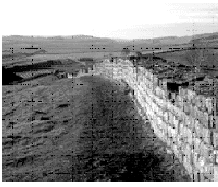Occupation in the Arley Valley
|
|
A trip to the History Shop last month proved very useful. Bob Blakeman has come up
trumps with details on the 1841 Blackrod census. In it there are entries for
‘Arley Blacking Mill’ and ‘Dooty Mill’ (presumably Doughty).
Families
According to the census Thomas Hart lived at the Blacking Mill as miller, aged 60, with
his son Robert age 13. At the Dooty Mill we have a family of eight including
possibly two sets of twins. The father, Richard Hull, was a collier and lived with
his wife Margaret, both aged 50. They had a son and daughter (Thomas and
Mary), both aged 20. Thomas was also a collier. They also had two
daughters aged 15, (Cicely and Dorinda), a son aged 14 (Henry), and a baby (John)
aged 12 months. The fact that there were colliers living here means that the mill
was out of use at this time and probably in a poor state of repair. Within just a
few years the building was completely demolished, to such an extent that nothing of it
appears on the 1846 Ordinance Survey. The inhabitation here has come as a complete
surprise to us, as at no time have we found any evidence of occupation from either site.
Blacking
Bob has also come up with a possible reason for the name Blacking. According to
the Encyclopaedia Britannica, logwood was imported from the West Indies and the dye it
produced was Black. In actual fact there is another Blacking Mill shown on the
6" 1st edition OS map further up the Douglas at Adlington. We also have a
report of a Blacking mill in Golborne which burned down in 1914, so perhaps it was not
such a rare process after all.
Excavation
The latest from the excavation is that we have uncovered a little bit more of the
Doughty mill, but the news is a bit disappointing. The stone wall we uncovered last
month is actually a stone plinth. The actual building wall appears on the other side
of this stone and is made of brick. This means the building is likely to be 17th or
18th century in date (not medieval).
Mill Race
In the meantime Tim MacAvoy has been working hard on mill race, and has uncovered a lot
of the stonework around where the second race branches off. There appears to be an
iron pipe here, which could be the discharge point from the sough shown on the Balcarres
map. He has also uncovered a lot of the timberwork around the mill race entrance,
including the remains of the sluice gate. The timbers are quite large, very well
made and in a remarkable state of preservation. This is due to the very wet
conditions. Once they have been recorded and photographed, we will rebury them in
situ. Last month Norman Redhead from the Manchester Archaeology Unit examined the
site and was very impressed.
Egyptology 
If, like me, you don’t know much about the ancient Egyptians, but would like to
more, John Johnson is running a ten week course at Abraham Guest School
in Orrell. The course is on basic Egyptology and will starting at the end
of this month on Tuesday evenings. He plans to have five lessons before Christmas
and five after, and price is £25 and £12.50 concessionary. John is our resident
Egyptologist and what he doesn’t know about the subject is not worth knowing.
For more information, contact John or me on 01942 741954.
Next meeting
The next meeting of the Society will be this Wednesday 1st October at the history shop
at 7.30 pm as usual. Again this month we have a slight change of plan. Instead of Tony
France, whose talk will now be next month, we will be showing a video of Hadrian’s
Wall, kindly lent to us by John Barker (again using Dave Thomas’s projection
equipment).
Hope to see you at the meeting - B.A.
|



